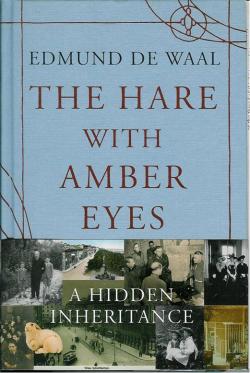The Hare with Amber Eyes, A Hidden Inheritance

Chatto and Windus , 2010, 354 pages, ISBN 9780701184179
Review by Sir Hugh Cortazzi
My attention was drawn to this book by a review in The Economist of 22 May 2010. It ended with the unusually enthusiastic recommendation: “Buy two copies of this book; keep one and give the other to your closest bookish friend.” The review was accompanied by a photograph of a number of Japanese netsuke (根付) with an ivory hare in the foreground. [A netsuke is a form of miniature sculpture developed in Japan from the 17th-century onwards which served both practical and aesthetic purposes.]
The author Edmund de Waal is a potter who has studied in Japan on a Daiwa scholarship and is now professor of ceramics at the University of Westminster. He inherited 264 antique netsuke, including the hare with the amber eyes. In this book he recounts how the collection was purchased by one of his ancestors in Paris during the height of the craze for things Japanese in the late nineteenth century, how they were transferred to Vienna, how they were rescued from the Nazis by Anna, his great grandmother’s maid, how they returned to Japan with his great uncle and how they are now in his London home.
This is, however, much more than the story of a netsuke collection. It is the moving story of his polyglot family, their circles in Paris and Vienna, their successes and their tragedies. The Ephrussi family began as wheat traders in Odessa and became bankers in European capitals on the scale of the Rothschilds.
The collection of netsuke was bought by Charles Ephrussi, a rich member of the family in Paris who had become an art collector and critic. It had been purchased by a dealer called Sichel in Japan in the 1870s at a time when antiques were being sold at very reasonable prices to the globe-trotters who had just discovered Japan. Charles had eclectic tastes and his interests were primarily in pictures. He patronised painters such as Renoir and Manet. He moved in the fashionable salons and became friendly with Proust who may have based the character of Swan on Charles. Charles led the life of a rich dilettante but he was seen as a member of the Jewish nouveau riche. This was not a happy time for such people in France. Anti-Semitism was rife and was exacerbated by the tragic Dreyfus affair. De Waal draws a sensitive picture of Paris at this time.
Charles Ephrussi decided to give his netsuke collection as a wedding present to Victor and Emmy Ephrussi of the Austrian branch of the bank. De Waal evokes the atmosphere of Vienna before the First World War. He describes the magnificent Ephrussi mansion on the Ringstrasse in Vienna and the life led by this worldly and wealthy Jewish family ennobled by the Hapsburg emperor. Victor Ephrussi, Edmund de Waal’s great-grandfather loyally supported the Austro-Hungrian government in the war which left the Austrian republic that emerged in 1918 feeble and unstable. The Ephrussi were impoverished but not yet destitute. The worst was still to come. The German Anschluss brought the Nazis to power in Austria. The property of the Ephrussi family was confiscated and it was only with great difficulty that Victor and Emmy got away to Slovakia. There Emmy died or committed suicide. Victor eventually joined his daughter, Edmund de Waal’s grandmother, in Tunbridge Wells. I found this section of the book particularly moving.
The last part is primarily devoted to the life in Japan of Edmund’s great-uncle Iggy (Ignace) Leo Ephrussi. The netsuke collection had passed to him after it had been handed to Edmund’s grandmother Elizabeth by Anna who had hidden and preserved it throughout the war. Iggy had left Austria before the Nazi take-over and had become an American citizen. He was an American intelligence officer in Europe in the Second World War. He arrived in Japan during the occupation, found Japan much to his liking and soon met his boy friend and later partner Jiro Sugiyama. Iggy became a successful banker and later saying he did not like Nixon reverted to Austrian nationality despite the shabby way in which the Austrian government dealt with Jewish claims for compensation.
I hope that the publishers can be induced to reprint this book with full colour illustrations not only of the netsuke, but also of some of the pictures and buildings which Edmund de Waal so graphically describes. Such illustrations as there are in this book have been cheaply scanned into the volume and do not do justice to Edmund de Waal’s sensitive writing.
The Hare with The Amber Eyes is only partly to do with Japan but I have no hesitation in reiterating the warm recommendation of The Economist and urge members of the Japan Society to buy and read this moving book.

